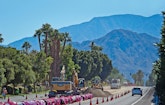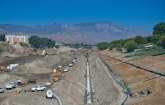
Workers replace a portion of the Coachella Canal at the SilverRock Golf Course. Because of summer’s heat, the concrete pours for the newly realigned canal are done overnight. The SilverRock Project involved the relocation of approximately 4,700 lineal feet of the Coachella Canal.
For more than 100 years, communities in the arid, sun-drenched Coachella Valley east of Los Angeles have drawn their drinking water from the 45-mile-long Coachella Valley aquifer that stretches from the Whitewater River canyon just west of Palm Springs to the Salton Sea.
And despite periodic declines in the amount of available water, the Coachella Valley Water District’s comprehensive management plan is helping ensure that water will be available years into the future. The plan includes entitlements to imported water from the Colorado River and the California State Water Project, drinking water wells and systems, aquifer recharge, recycle and reuse of treated wastewater, conservation, irrigation, irrigation drainage and stormwater management.
“We are unique in that we provide each type of water-related service while serving over 100,000 connections, yet depend entirely on the groundwater basin for our domestic water supply,” says Steve Bigley, director of environmental services. “There aren’t many agencies in the U.S. — if any — that are like that.
“It’s a testament to the wisdom of the people who formed the water district 100 years ago and managed it for decades,” he says of the planning. “They had the foresight. They recognized the value of the groundwater basin the whole valley depends on.”
Bigley says the amount of groundwater storage in the basin this year is higher than it’s ever been, thanks to a snowy winter in 2016-17. “We stored over 380,000 acre-feet of water, which not only improves aquifer levels, but also helps prevent subsidence (in ground levels). We’ve actually seen uplift in some areas.”
The district
The slogan “Valley of the Sun” belongs to Phoenix, but it could well be applied to the Coachella Valley. Summer temperatures average over 100 degrees F during the day, and the area receives only 3 to 4 inches of rain a year. Still, its proximity to Los Angeles, lush golf courses, and historic architecture have drawn over 450,000 folks who live there, including many movie stars and headline entertainers. Another 200,000 to 300,000 tourists visit annually, escaping cold weather elsewhere.
The district encompasses 1,000 square miles and is one of two agencies importing water to help manage water resources in the region. Its customers use about 90 mgd of domestic water. The organization is governed by a publicly elected board of directors and funded through property taxes and user rates.
The district operates five wastewater treatment plants — two of which produce tertiary level reclaimed water for recycling — three drinking water treatment plants, two large aquifer replenishment facilities with a third one under construction, about one hundred drinking water wells, over 1,000 miles of drinking water pipelines and wastewater sewers, irrigation and irrigation drainage grids, and stormwater management. The district is also responsible for the 123-mile-long Coachella Canal, which brings water by gravity flow from the Colorado River, and maintains a critical arrangement with the Metropolitan Water District of Southern California, exchanging Colorado River water for water from the State Water Project, bucket for bucket. Coachella is one of only two agencies in the state having access to both imported water sources.
Domestic water
To provide clean water for domestic use, wells ranging in depth from 800 to 1,800 feet typically draw between 1,800 and 2,000 gpm from the aquifer.
In 1990, the district began adding chlorine at its wells to meet revised bacteria standards. “The water drawn from our wells meets bacteria standards without treatment but chlorine maintains this quality in the water system,” Bigley says. He adds that California’s hexavalent chromium (chromium 6) standard adopted in 2014 triggered extensive treatment technology research by the district due to naturally occurring chromium 6 found in many of its wells.
Plans to install conventional treatment facilities costing over $250 million were put on hold late in 2016 when it discovered a more economical chemical reduction method. “We have recently demonstrated a cost-effective method to reduce chromium 6 in drinking water that is ready to go,” Bigley says, “but California had to withdraw the regulations and is beginning the process needed to adopt a replacement standard. It’s been a real roller-coaster ride for us.”
Five wells near the Salton Sea at the district’s far eastern edge use ion exchange to comply with the revised arsenic standard adopted in 2001.
The treated water is stored in more than 60 elevated reservoirs located in the foothills around the region. The largest has a capacity of 12 million gallons.
Farms and the 120-plus golf courses in the area are large water users, and the district fulfills much of their irrigation needs with raw Colorado River water and recycled wastewater. The district also maintains the area’s 480 miles of irrigation drainage pipes, which collect subsurface drainage largely from agricultural lands and direct it to the Salton Sea.
“There are 65,000 acres of farmland within our district boundaries,” says Dan Charlton, director of facilities and maintenance. The drainage system is designed to convey agricultural drain water, maintain groundwater levels beneath the farms, and prevent salt buildup in the soil. At some point in the future, this source may help meet future water demands.
Conserving water
As another means of protecting and preserving the aquifer, the district aggressively promotes water conservation. Customers are encouraged to install low-flow toilets and smart sprinkler and irrigation systems. A turf buyback program has reduced the number of green-grass yards. As a result, domestic water demand has been reduced by about 20 percent since 2013.
Although the area receives little rain, storms in the mountains and across the district can create raging torrents of stormwater. To limit damage from such events, the district maintains a 600-foot-wide storm channel, which runs down the center of the region, fed by 16 tributary channels. “The Coachella Valley has the potential for some of the most severe alluvial fan flooding in the nation,” Charlton says. “The surrounding mountains are hardscapes, and the channels are our lifelines from a stormwater perspective. Our goal is to protect life and property.”
The district has been a pioneer in automated monitoring and operating its sprawling water system. “We started in the ’60s, using microwave towers to communicate with remote field systems, specifically the Coachella Canal, which begins just west of Yuma, Arizona,” Bigley says. “Operators could control the gates along the canal from a control center — pretty advanced technology for that time.”
Today, the district is improving this SCADA system and plugging in new Wonderware software (Schneider Electric - Invensys) to sync with the microwave towers and field-based PLCs. “The systems have setpoints; setpoints trigger alarms; and alarms trigger action,” Charlton says. “It’s our eyes and ears in the field.”
Replenishment
If SCADA is the brain, the replenishment facilities are the heart of the system. They trace their beginning back 100 years — long before groundwater recharge became common. “In 1918, we hired an engineer to develop facilities to capture the stormwater coming down the Whitewater River channel,” Bigley explains. “We were doing it way back then.”
Near the site of that early installation, the Whitewater Groundwater Replenishment Facility has since been expanded to more than 700 acres and now includes diversion structures, which head a series of 19 percolation ponds. The ponds range in size from 13 to 58 acres and allow imported water, as well as snowmelt from the San Gorgonio Mountains to percolate into the sandy soil and replenish the aquifer.
At the eastern end of the district, the Thomas E. Levy Groundwater Replenishment Facility was commissioned in July 2009 to replenish up to 40,000 acre-feet of Colorado River water annually. It is 163 acres in size and contains 41 percolation ponds. The Palm Desert Groundwater Replenishment Facility will have a capacity of 25,000 acre-feet when finished in early 2019.
Based on the Engineer’s Report for 2017, the replenishment facilities have received over 1.2 trillion gallons of imported water, and for the first time, each groundwater basin benefitting from the district’s replenishment program showed a positive 10-year running annual average change in storage — indicating no overdrafts of the groundwater aquifer.
The district, and the neighboring Desert Water Agency, began importing water from the State Water Project in 1973; and their combined amount represents the third largest among the 29 State Water Project contractors. The district holds secure, senior rights to Colorado River water according to the Colorado River Compact signed in 1922 and has always received its full allotment.
In addition to replenishing the aquifer, district projects have helped minimize and — in much of the Coachella Valley — eliminate land subsidence, or settling of ground over the aquifer. “We saw limited subsidence from 1936 to 1996, about 2 feet in total,” Bigley says. “But now we’re getting uplift in some areas. Proper management of the groundwater basin has helped to stabilize the surface.”
“Without implementing the water management plan and imported water, we would be in continued overdraft,” Bigley says. “But that’s not the case.”
He says the Coachella Canal — which opened in 1949 — and the reduction of pumping groundwater through privately owned wells have saved the day. Efforts to increase the amount of imported water have helped as well. The district and Desert Water Agency have continued to enter agreements to receive additional supplies or increase the reliability of existing allotments.
Following California’s multiyear drought, 2017 brought record precipitation in the Sierras, leading to more than 386,000 acre-feet of replenishment at the Whitewater Groundwater Replenishment Facility — enough water to cover 1 acre with a hypothetical tower of water 73.1 miles high, points out Charlton. “It was a record year for replenishment.”
Critical maintenance
Proper maintenance is important. Charlton says during banner replenishment years, silt in the Colorado River water and sediment from the earthen conveyance channel can plug pores and interfere with percolation. His maintenance staff routinely removes sediment from the ponds and uses dozers to rip the hard surface that forms on the surface of the pond, allowing the water to soak through the sugar sand.
The crews have also developed new techniques for dealing with abrasion caused by rock and sediment entering the percolation ponds at high velocity. “We’re building bifurcated boxes for the inlet structures,” Charlton explains. The boxes provide an outlet to adjacent ponds and are equipped with gates that can be alternately opened or closed to provide flexibility of the delivery location.
“We have a great staff,” Bigley says. “They’ve developed the art and science of replenishment, getting maximum efficiency out of our percolation basins.”
Charlton’s crew also maintains the stormwater channel and the Coachella Canal, as well as the irrigation distribution and drainage systems. “Sediment is the usual issue,” he says. “Whether it is dredging the canal or jetting the closed piping system, the conveyance of water needs to continue. Staff is very committed and does an excellent job.”
Planning for the future
While Bigley, Charlton, and others express appreciation for the foresight of water planners 100 years ago, they are conscious of the need to keep their water management plan updated and forward looking. The current plan was developed in 2002 and modified in 2010, and it is designed to protect and preserve local water resources through 2035.
“The management plan is very important,” Bigley says. It recognizes the need for Coachella Valley water to be sustainable and the valley’s dependence upon imported water.
The future of the State Water Project may hinge on the outcome of discussions over environmental concerns and the needs of the public in the San Francisco Bay Area and Delta region near Sacramento. One proposed solution, known as California WaterFix, is subject to legislative action and possibly a public referendum. The plan would construct massive tunnels to convey raw water from the Sacramento River to the downstream side of the environmentally sensitive Delta area. Concerns relate to endangered fish species and the intrusion of salt water from the Bay.
The district plan also addresses aging infrastructure. “Even though our systems are not as old as those in Eastern cities, some of our pipes date back to the ’60s,” Bigley explains. “Buried infrastructure represents a huge cost liability. We are preparing and planning and obtaining a bond rating for the first time in our history.”
Asset management is also in the works. Charlton says the district is developing and implementing a forward-thinking asset management program to provide a comprehensive database to manage the district’s $1.3 billion in capital assets. “The team is currently performing an asset inventory and condition assessment of our assets, which will be followed by the completion of valuation and an accounting of the life cycle status of each asset.”
Like most water agencies, Coachella faces retirements and the need to find qualified new people and retain institutional knowledge. Bigley says cross-training and leadership development are very important. He adds that despite the warm winter weather, it’s often difficult to find technical specialists who want to live in the valley year-round when summer daytime temperatures exceed 100 degrees F.
Other features of the district plan include expanding the recycling program, continued conservation, and possible desalination of agricultural drainage water. The district’s public outreach and educational programs are a critical component to the success of the district, Charlton says. “Emphasizing the need to communicate the water story both inside and outside the agency is paramount.
“We need to promote a global understanding of the district priorities to ensure there is a sustainable water supply for future generations.”
A history of twists and turns
The history of water in the Coachella Valley (California) twists and turns like a willful river, rife with torrents and dry spells, often kept flowing by political foresight and creative agreements.
Today, the average citizen of Palm Springs, Indio or the other communities in the valley probably doesn’t fully appreciate the efforts that have led to the flow of clean water from the taps or the irrigation water supplying the area’s rich farmlands.
But Tom Levy does. Now retired from the Coachella Valley Water District, Levy knows the history of the district all the way back to its beginning in the early 1900s and reflects on its development through the rest of the 20th century and now, into the 21st.
“It was back in 1917 when the nearby Imperial Irrigation District had the idea to import water from the Whitewater River and use it for irrigating crops,” he says.
“They were farming off wells, and water levels had already begun to drop. Their ambitions prompted the Coachella Valley Water District to form in 1918, as a way of protecting the water supply for the valley.”
It wasn’t long, however, before the district recognized the need for additional water sources, and thus began a long political process that resulted in the landmark Boulder Canyon Project Act in 1928 that built the Hoover Dam along with the All-American and Coachella canals.
“There were many multiday train trips to Washington by officials from the district,” Levy says. “And though the Hoover Dam was completed in 1936, the construction of the canals bringing Colorado River water to the valley was interrupted by World War II and not completed until 1948.”
The act also spelled out allocations of Colorado River water among seven states, including California. Levy chuckles and notes, “Through ‘good engineering,’ the agreement allocated 7.5 million acre-feet of river water a year, even though on average, the river doesn’t produce that.”
Ultimately, through a priority system agreed upon after considerable political haggling, California was allotted 4.4 million acre-feet per year.
That didn’t solve the longer-term problem, however. Levy compares the Coachella Valley to a bathtub with water entering at the north end and exiting at the south, building up dense layers of silt as it moves through the valley. “The soil was salty, and it built up in the irrigation water,” he explains. To address the problem, a drain system was constructed to take agricultural runoff water to the Salton Sea.
“Then in 1963 community leaders and board members recognized the residential and commercial potential of the entire valley and determined there was a need for even more imported water,” he says, noting their amazing foresight.
The answer was the California State Water Project, which piped water from the Delta area near Sacramento to Southern California.
But access was a problem. “It would have cost half a billion dollars or more to build an aqueduct through the mountains into the valley,” Levy says. “The district scratched their heads and came up with an ingenious plan that would let the Metropolitan Water District of Southern California use Coachella Valley’s share of the water from the State Water Project, while Coachella would take Metro’s allotment of Colorado River water, in an even-up swap.”
Despite the twists and turns, Levy remains confident the Coachella Valley will have enough water to meet demands long into the future.
The Quantitative Settlement Agreement of 2003 — finally adjudicated after decades of court opinions — clarified allotments of Colorado River water among the California agencies and assured a steady supply for the district. The agreement extends through 2078.
Meanwhile, the future of water from the State Water Project remains tangled in arguments over fish populations, threatened species and seawater contamination. “It’s the quagmire of quagmires,” Levy says. “But it will change because Southern California is where the voters are. Eventually we’re going to get some rationale.”.









